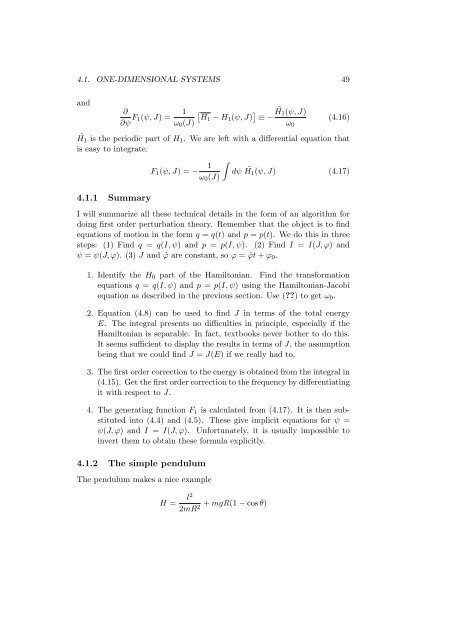Nonlinear Mechanics - Physics at Oregon State University
Nonlinear Mechanics - Physics at Oregon State University
Nonlinear Mechanics - Physics at Oregon State University
Create successful ePaper yourself
Turn your PDF publications into a flip-book with our unique Google optimized e-Paper software.
4.1. ONE-DIMENSIONAL SYSTEMS 49<br />
and<br />
∂<br />
∂ψ F1(ψ, J) = 1 [<br />
H1 − H1(ψ, J)<br />
ω0(J)<br />
] ≡ − ˜ H1(ψ, J)<br />
ω0<br />
(4.16)<br />
˜H1 is the periodic part of H1. We are left with a differential equ<strong>at</strong>ion th<strong>at</strong><br />
is easy to integr<strong>at</strong>e.<br />
F1(ψ, J) = − 1<br />
∫<br />
dψ<br />
ω0(J)<br />
˜ H1(ψ, J) (4.17)<br />
4.1.1 Summary<br />
I will summarize all these technical details in the form of an algorithm for<br />
doing first order perturb<strong>at</strong>ion theory. Remember th<strong>at</strong> the object is to find<br />
equ<strong>at</strong>ions of motion in the form q = q(t) and p = p(t). We do this in three<br />
steps: (1) Find q = q(I, ψ) and p = p(I, ψ). (2) Find I = I(J, φ) and<br />
ψ = ψ(J, φ). (3) J and ˙φ are constant, so φ = ˙φt + φ0.<br />
1. Identify the H0 part of the Hamiltonian. Find the transform<strong>at</strong>ion<br />
equ<strong>at</strong>ions q = q(I, ψ) and p = p(I, ψ) using the Hamiltonian-Jacobi<br />
equ<strong>at</strong>ion as described in the previous section. Use (??) to get ω0.<br />
2. Equ<strong>at</strong>ion (4.8) can be used to find J in terms of the total energy<br />
E. The integral presents no difficulties in principle, especially if the<br />
Hamiltonian is separable. In fact, textbooks never bother to do this.<br />
It seems sufficient to display the results in terms of J, the assumption<br />
being th<strong>at</strong> we could find J = J(E) if we really had to.<br />
3. The first order correction to the energy is obtained from the integral in<br />
(4.15). Get the first order correction to the frequency by differenti<strong>at</strong>ing<br />
it with respect to J.<br />
4. The gener<strong>at</strong>ing function F1 is calcul<strong>at</strong>ed from (4.17). It is then substituted<br />
into (4.4) and (4.5). These give implicit equ<strong>at</strong>ions for ψ =<br />
ψ(J, φ) and I = I(J, φ). Unfortun<strong>at</strong>ely, it is usually impossible to<br />
invert them to obtain these formula explicitly.<br />
4.1.2 The simple pendulum<br />
The pendulum makes a nice example<br />
H = l2<br />
+ mgR(1 − cos θ)<br />
2mR2
















